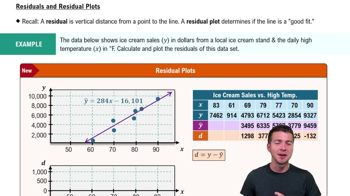Here are the essential concepts you must grasp in order to answer the question correctly.
Outliers
Outliers are data points that significantly differ from other observations in a dataset. They can skew the results of statistical analyses and may indicate variability in measurement, experimental errors, or novel phenomena. In a box-and-whisker plot, outliers are typically identified as points that lie beyond 1.5 times the interquartile range (IQR) from the quartiles.
Recommended video:
Comparing Mean vs. Median
Box-and-Whisker Plot
A box-and-whisker plot is a graphical representation of a dataset that displays its central tendency and variability. It consists of a box that represents the interquartile range (IQR), with lines (whiskers) extending to the minimum and maximum values within 1.5 times the IQR. This plot helps visualize the distribution of data, including the median, quartiles, and potential outliers.
Recommended video:
Residuals and Residual Plots
Interquartile Range (IQR)
The interquartile range (IQR) is a measure of statistical dispersion that represents the range within which the central 50% of the data lies. It is calculated by subtracting the first quartile (Q1) from the third quartile (Q3). The IQR is crucial for identifying outliers and understanding the spread of the data, as it is less affected by extreme values than the overall range.
Recommended video:
Find 5-Number Summary - TI-84 Calculator Example 1
 Verified step by step guidance
Verified step by step guidance Verified video answer for a similar problem:
Verified video answer for a similar problem:

